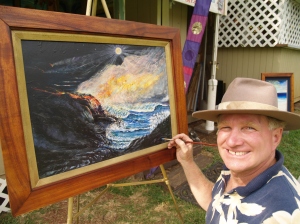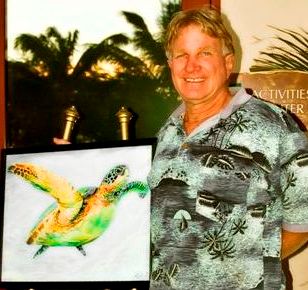Volcano Update
Reprinted from the USGS Volcano Watch webpage. 
|
| Strong trade winds fan the gas-and-ash plume from Halema`uma`u in this early morning photo from the Steaming Bluff overlook. March 31, 2008 |
Hundreds of visitors are driving to Kalapana each day to see the ocean entries of Kilauea's east-rift lava flows. As these visitors watch the flows, they may be under the impression that the hazards are calculable and that slow and steady streams of lava into the ocean characterize the nature of eruptions at Kilauea. The explosion that occurred at the summit on March 19th reminded us all that Kilauea can also be an explosive volcano.
Large explosions in Hawaii's geologic history are recorded by the ash deposits that blanket the region surrounding Kilauea. These ash deposits are as recent as 1924 and as old as 40,000 years ago.
From the 1500s to the early 1800s, a number of explosions at Kilauea punctuated its terrain. The eruption of 1790 is of particular note because of its association with the explosion that killed about a third of chief Keoua's warriors going to battle chief Kamehameha in the Ka`u district to the south. The event contributed to the fall of Keoua and, in turn, to the ascent of Kamehameha as the first ruling monarch of the Hawaiian Islands.
The 1924 eruption of Halema`uma`u was the most recent, and most well-documented, explosive event at Kilauea. An excellent article describing this eruption can be read online at http://hvo.wr.usgs.gov/kilauea/history/1924May18/.
But what of the character of the March 19th explosion? Is it much different than earlier Kilauea explosions? Our answer to this question is uncertain because of the size of the explosion. By Kilauea's standards, the March 19th explosion was tiny. We currently estimate that the initial explosion excavated on the order of 10,000 tons of rock from Kilauea. By comparison, the 1924 eruption excavated on the order of a million tons of rock. The 1790 eruption is known to have been larger than the one in 1924 and the known prehistoric explosions even larger.
The larger the explosion, the more likely its products, like ash, can be preserved. Because the records of past explosive events, like the one on March 19th, may have been literally blown away, we can only compare it to the large, previously recorded explosions in Kilauea's history. We're currently observing this problem today. Much of the ash that fell from the initial explosion on March 19th is being swept away into the Ka`u desert and out into the ocean. If not for our monitoring records-both automated and human observations around the clock-this event may not even be identifiable in the future.
The 1924 and 1790 eruptions differed from the current one in that they were not only larger, but phreatic. This class of eruption occurs when ground water interacts with super-heated rocks and magma, forming steam that explodes under pressure. The March 19th explosion contained none of the hallmarks of a phreatic explosion, such as wet ash and mud pellets, or lapilli. Instead, the ash produced was dry and consisted largely of lithics, or rock fragments, and glass particles from the magma below the surface.
The exact mechanism that caused the March 19th explosion is currently being investigated, described, and refined. But the important conclusion that we can now draw is that these smaller explosions may be a normal part of Kilauea's character that we have not recognized. The volcano reveals itself to us by degrees, keeping us guessing, tantalizing us to explore, inquire, and uncover its mysteries.
Activity update
Kilauea summit and Pu`u `O`o continued to deflate. Sulfur dioxide emission rates at the summit have decreased over the past week but are still elevated; seismic tremor levels have remained elevated at several times background levels. Earthquakes were located primarily beneath Halema`uma`u Crater and the adjacent areas, the southwest rift zone, and the south flank faults.
Lava from the 2007 Thanksgiving Eve Breakout (TEB) flow, erupting from fissure D of the July 21 eruption, continues to flow through what remains of the Royal Gardens subdivision and across the coastal plain. On Wednesday, March 5, the flow entered the ocean (Waikupanaha entry) in the vicinity of Kapa`ahu. The Waikupanaha delta has since grown to a width of about 1,000 m (3,280 ft) and has multiple entry points. On March 15, another branch of the flow reached the ocean (Ki entry) farther to the east, within a few hundred meters of the lava viewing area. As of Thursday, April 3, both the Waikupanaha and Ki entries remained active.
The public should be aware that the ocean entry areas could collapse at any time, potentially generating large explosions in the process. The steam clouds rising from the entry areas are highly acidic and laced with glass particles. Do not venture onto the lava deltas. Even the intervening beaches are susceptible to large waves suddenly generated during delta collapse; these beaches should be avoided. Check the County of Hawai`i Civil Defense website (http://www.lavainfo.us) for information on public access to the coastal plain and ocean entry.
In the past few weeks, sporadic breakouts have burst from the lava tube on the steep slopes within the Royal Gardens subdivision; however, their size and frequency seem to have diminished over the past week. Closer to the TEB vent, on the south side of Kupaianaha, an area of recent persistent breakouts on the northeast side of the shield complex was observed to be inactive on April 3.
Weak incandescence has been intermittently observed at night in Pu`u `O`o in the past week. As in years past, Pu`u `O`o likely is serving as a large chimney, beneath which lava is briefly stored and substantially degassed on its way to the eruption site.
On March 11, a new fumarole appeared low on the southeast wall of Halema`uma`u Crater, within Kilauea's summit caldera. The new vent is located directly beneath the Halema`uma`u Overlook about 70 m (230 ft) down. At 2:58 a.m. on March 19, a small explosion occurred from this fumarole. The explosion scattered rock debris over an area of about 75 acres, covering a narrow section of Crater Rim Drive, the entire Halema`uma`u parking area, and the trail leading to the overlook. The overlook was damaged by rocks that reached up to 90 cm (3 ft) across. No lava was erupted as part of the explosion, suggesting that the activity was driven by hydrothermal or gas sources. The new explosion pit continues to vigorously vent gas and ash, with the plume alternating between brown (ash-rich) and white (ash-poor). Fresh lava spatter, Pele's tears and Pele's hair have been collected at the rim, indicating that magma resides at shallow depths in the new conduit.
Sulfur dioxide (SO2) emission rates from the summit area have been substantially elevated up to 10 times background values since early January; the emission rates for the past week have been decreasing but are still elevated. The increase in sulfur dioxide emission rates at the summit means that SO2 concentrations are much more likely to be at hazardous levels for visitor areas downwind of Halema`uma`u, especially during weak wind conditions or when winds blow from the south. Most people are sensitive to sulfur dioxide at these levels, especially children, individuals with asthma, chronic obstructive pulmonary disease (COPD), or other breathing problems. Stay informed about SO2 concentrations in continuously monitored areas (Jaggar Museum and Kilauea Visitor Center) by visiting the Kilauea Visitor Center and the web at:
http://www2.nature.nps.gov/air/webcams/parks/havoso2alert/havoalert.cfm. To minimize these potentially harmful effects, Hawai`i Volcanoes National Park has closed all access to the southern half of Kilauea caldera.
One earthquake beneath Hawai`i Island was reported felt within the past week. A magnitude-1.5 earthquake occurred at 4:01 a.m., H.s.t., on Monday, March 31, 2008, and was located 13 km (8 miles) southeast of Kilauea summit at a depth of 6 km (4 miles).
Mauna Loa is not erupting. No earthquakes were located beneath the summit. The rate of extension between locations spanning the summit, indicating inflation, has decreased to values below current detection limits.
Visit our Web site (http://hvo.wr.usgs.gov) for daily Kilauea eruption updates and nearly real-time Hawai`i earthquake information. Kilauea daily update summaries are also available by phone at (808) 967-8862.
For more information on visiting visiting Hawaii in general and touring the volcano in particular, go to www.tourguidehawaii.com and www.lovingthebigisland.wordpress.com.

pimp myspace
One might ask why one would want to reneder a video into GIF annimation. One might, but one would be a total noob to do so. Beacuse it's cool, dude...check it out!
Go to: http://gickr.com/from_youtube!



















